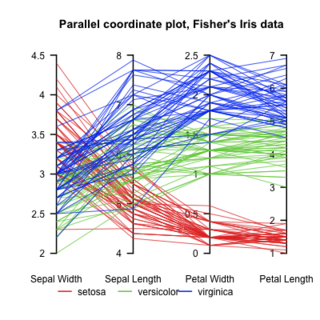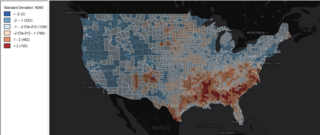Related Research Articles

A bar chart or bar graph is a chart or graph that presents categorical data with rectangular bars with heights or lengths proportional to the values that they represent. The bars can be plotted vertically or horizontally. A vertical bar chart is sometimes called a column chart.

Scientific visualization is an interdisciplinary branch of science concerned with the visualization of scientific phenomena. It is also considered a subset of computer graphics, a branch of computer science. The purpose of scientific visualization is to graphically illustrate scientific data to enable scientists to understand, illustrate, and glean insight from their data. Research into how people read and misread various types of visualizations is helping to determine what types and features of visualizations are most understandable and effective in conveying information.

Visualization or visualisation is any technique for creating images, diagrams, or animations to communicate a message. Visualization through visual imagery has been an effective way to communicate both abstract and concrete ideas since the dawn of humanity. from history include cave paintings, Egyptian hieroglyphs, Greek geometry, and Leonardo da Vinci's revolutionary methods of technical drawing for engineering and scientific purposes.

In scientific visualization and computer graphics, volume rendering is a set of techniques used to display a 2D projection of a 3D discretely sampled data set, typically a 3D scalar field.

Parallel coordinates are a common way of visualizing and analyzing high-dimensional datasets.
Geovisualization or geovisualisation, also known as cartographic visualization, refers to a set of tools and techniques supporting the analysis of geospatial data through the use of interactive visualization.

Spatial analysis is any of the formal techniques which studies entities using their topological, geometric, or geographic properties. Spatial analysis includes a variety of techniques using different analytic approaches, especially spatial statistics. It may be applied in fields as diverse as astronomy, with its studies of the placement of galaxies in the cosmos, or to chip fabrication engineering, with its use of "place and route" algorithms to build complex wiring structures. In a more restricted sense, spatial analysis is geospatial analysis, the technique applied to structures at the human scale, most notably in the analysis of geographic data. It may also be applied to genomics, as in transcriptomics data.

Data and information visualization is the practice of designing and creating easy-to-communicate and easy-to-understand graphic or visual representations of a large amount of complex quantitative and qualitative data and information with the help of static, dynamic or interactive visual items. Typically based on data and information collected from a certain domain of expertise, these visualizations are intended for a broader audience to help them visually explore and discover, quickly understand, interpret and gain important insights into otherwise difficult-to-identify structures, relationships, correlations, local and global patterns, trends, variations, constancy, clusters, outliers and unusual groupings within data. When intended for the general public to convey a concise version of known, specific information in a clear and engaging manner, it is typically called information graphics.

A heat map is a 2-dimensional data visualization technique that represents the magnitude of individual values within a dataset as a color. The variation in color may be by hue or intensity.

Data fusion is the process of integrating multiple data sources to produce more consistent, accurate, and useful information than that provided by any individual data source.

ParaView is an open-source multiple-platform application for interactive, scientific visualization. It has a client–server architecture to facilitate remote visualization of datasets, and generates level of detail (LOD) models to maintain interactive frame rates for large datasets. It is an application built on top of the Visualization Toolkit (VTK) libraries. ParaView is an application designed for data parallelism on shared-memory or distributed-memory multicomputers and clusters. It can also be run as a single-computer application.

GeoDa is a free software package that conducts spatial data analysis, geovisualization, spatial autocorrelation and spatial modeling.

Visual analytics is an outgrowth of the fields of information visualization and scientific visualization that focuses on analytical reasoning facilitated by interactive visual interfaces.
In databases, brushing and linking is the connection of two or more views of the same data, such that a change to the representation in one view affects the representation in the other. Brushing and linking is also an important technique in interactive visual analysis, a method for performing visual exploration and analysis of large, structured data sets.
In computing, 3D interaction is a form of human-machine interaction where users are able to move and perform interaction in 3D space. Both human and machine process information where the physical position of elements in the 3D space is relevant.
Cultural analytics refers to the use of computational, visualization, and big data methods for the exploration of contemporary and historical cultures. While digital humanities research has focused on text data, cultural analytics has a particular focus on massive cultural data sets of visual material – both digitized visual artifacts and contemporary visual and interactive media. Taking on the challenge of how to best explore large collections of rich cultural content, cultural analytics researchers developed new methods and intuitive visual techniques that rely on high-resolution visualization and digital image processing. These methods are used to address both the existing research questions in humanities, to explore new questions, and to develop new theoretical concepts that fit the mega-scale of digital culture in the early 21st century.

Voreen is an open-source volume visualization library and development platform. Through the use of GPU-based volume rendering techniques it allows high frame rates on standard graphics hardware to support interactive volume exploration.
The Trade Space Visualizer is a data visualization tool developed at the Applied Research Laboratory (ARL) at The Pennsylvania State University. Initial development started in 2002, and it is currently supported by a team at ARL/Penn State.

A motion chart is a dynamic bubble chart which allows efficient and interactive exploration and visualization of longitudinal multivariate data. Motion charts provide mechanisms for mapping ordinal, nominal and quantitative variables onto time, 2D coordinate axes, size, colors, glyphs and appearance characteristics, which facilitate the interactive display of multidimensional and temporal data.
Data exploration is an approach similar to initial data analysis, whereby a data analyst uses visual exploration to understand what is in a dataset and the characteristics of the data, rather than through traditional data management systems. These characteristics can include size or amount of data, completeness of the data, correctness of the data, possible relationships amongst data elements or files/tables in the data.
References
- 1 2 3 4 5 6 7 Interactive Visual Analysis of Scientific Data. Steffen Oeltze, Helmut Doleisch, Helwig Hauser, Gunther Weber. Presentation at IEEE VisWeek 2012, Seattle (WA), USA
- 1 2 Hauser, Helwig. "Generalizing focus+ context visualization." Scientific visualization: The visual extraction of knowledge from data. Springer Berlin Heidelberg, 2006. 305-327.
- ↑ Gresh, Donna L., et al. "WEAVE: A system for visually linking 3-D and statistical visualizations, applied to cardiac simulation and measurement data." Proceedings of the conference on Visualization'00. IEEE Computer Society Press, 2000.
- ↑ Doleisch, Helmut, Martin Gasser, and Helwig Hauser. "Interactive feature specification for focus+ context visualization of complex simulation data." Proceedings of the symposium on Data visualisation 2003. Eurographics Association, 2003.
- 1 2 Doleisch, Helmut. Visual analysis of complex simulation data using multiple heterogenous views. 2004.
- 1 2 3 Kehrer, Johannes. Interactive visual analysis of multi-faceted scientific data. PhD dissertation, Department of Informatics, University of Bergen, Norway, 2011.
- 1 2 3 4 5 Konyha, Zoltán, et al. "Interactive visual analysis of families of curves using data aggregation and derivation." Proceedings of the 12th International Conference on Knowledge Management and Knowledge Technologies. ACM, 2012.
- ↑ Matkovic, Krešimir, et al. "ComVis: A coordinated multiple views system for prototyping new visualization technology." Information Visualisation, 2008. IV'08. 12th International Conference. IEEE, 2008
- ↑ Roberts, Jonathan C. "State of the art: Coordinated & multiple views in exploratory visualization." Coordinated and Multiple Views in Exploratory Visualization, 2007. CMV'07. Fifth International Conference on. IEEE, 2007.
- ↑ Martin, Allen R., and Matthew O. Ward. "High dimensional brushing for interactive exploration of multivariate data." Proceedings of the 6th Conference on Visualization'95. IEEE Computer Society, 1995.
- ↑ Keim, Daniel A. "Information visualization and visual data mining." Visualization and Computer Graphics, IEEE Transactions on 8.1 (2002): 1-8.
- ↑ Doleisch, Helmut, and Helwig Hauser. "Smooth brushing for focus+ context visualization of simulation data in 3D." Journal of WSCG 10.1 (2002): 147-154.
- ↑ Lamping, John, Ramana Rao, and Peter Pirolli. "A focus+ context technique based on hyperbolic geometry for visualizing large hierarchies." Proceedings of the SIGCHI conference on Human factors in computing systems. ACM Press/Addison-Wesley Publishing Co., 1995.
- 1 2 Konyha, Zoltan, et al. "Interactive visual analysis of families of function graphs." Visualization and Computer Graphics, IEEE Transactions on 12.6 (2006): 1373-1385.
- 1 2 3 4 Oeltze, Steffen, et al. "Interactive visual analysis of perfusion data." Visualization and Computer Graphics, IEEE Transactions on 13.6 (2007): 1392-1399.